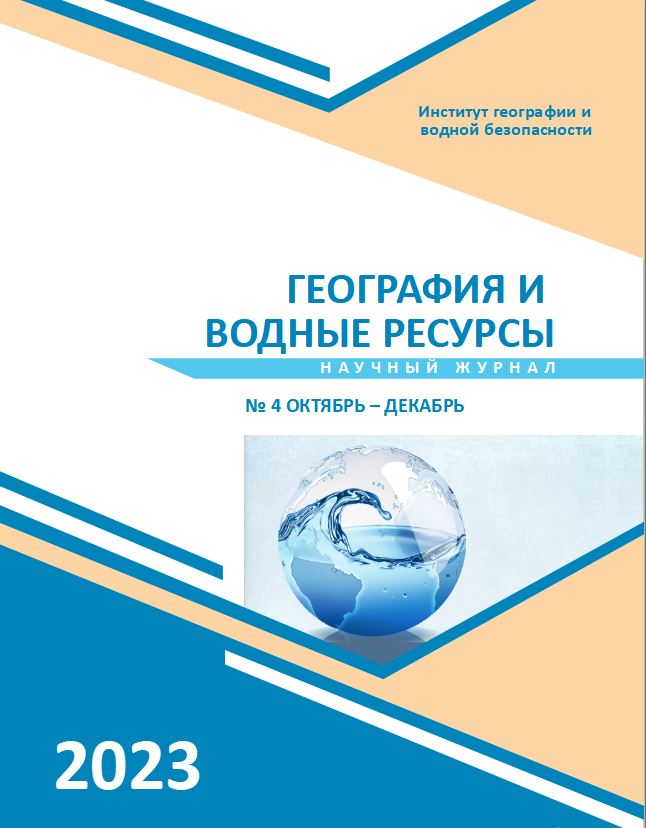TRANSFORMATION OF THE AMUDARYA RIVER BASIN IN THE CONTEXT OF CLIMATE CHANGE
Main Article Content
Abstract
Abstract. The article assesses the impact of climate change on the water resources of the Amudarya River
basin. The Amudarya River is fed by thawed snow and glacial waters. Glaciers have a significant role in the water
supply of agriculture, as well as hydropower. Due to the intensive melting of glaciers in the short term, the flow of
some rivers will increase. However, in the long term, the runoff will decrease, and some glaciers may disappear
altogether. An important task of this study was to take into account the work of researchers working on environmental problems in the Amudarya basin. Since the ecology of the transboundary Amudarya River is in the sphere of
national interests of several countries: Tajikistan, Uzbekistan, Turkmenistan and Kazakhstan, certain conditions for cross-border cooperation are being formed. The main problem of cooperation is unstable river regimes, which require continuous planning and negotiations on the allocation of resources, and which are exacerbated by climate change. The main consequences of the influence of climate change on the formation of water resources and water use in the Amudarya River basin are highlighted.
Article Details
References
About the Amu Darya River Basin – Amu Darya Basin Network [Electronic resource]. – URL:
http://amudaryabasin.net/ru/content/151
Agamyrat Soltanov. Amudarya: from antiquity to the present day – the electronic newspaper "Altyn Asyr" [Electronic
resource]. – Turkmenistan, 2022. – URL: https://www.turkmenistan.gov.tm/tk
Dukhovny V.A., Ziganshina D.R., Sorokin A.G. The future of the Amudarya basin under climate change. – Tashkent:
SIC ICWC of Central Asia, 2018. – 328 p.
Zering D., Diebold A. From glaciers to the Aral Sea – water unites. –Berlin, 2012. – 263 p.
Franz Goerlich, Tobias Bolch, and Frank Paul. More dynamic than expected: an updated survey of surging glaciers in the
Pamir – Earth System Science Data, ESSD, 12, 3161-3176, 2020. https://doi.org/10.5194/essd-12-3161-2020.
Abdushukurov J.A., Salibayeva Z.N. Ecological assessment of water quality in the main tributaries of the Amudarya
[Electronic resource]. – URL:http://www.cawater-info.net/amudarya-knowledge-base/papers.htm
Abdushukurov D.A., Kobuliev Z.V., Mamadaliev B.N. Elemental composition of bottom sediments and adjacent soils on
the major tributaries of Amudarya // Science and New Technologies. 2014. N 6.
Alikhanov B., Khudaiberganov A. Favorable ecology is a solid basis for countering the spread of viral infections //
Newspaper “The truth of the East”. 2020. N 110.
Second assessment of transboundary Rivers, lakes and Groundwater – United Nations Economic Commission for
Europe. – New York; Geneva, 2011.
Amudarya Basin Water Management Organization//CAWATERinfo [Electronic resource]. – URL: http://www.cawaterinfo.net/amudarya/index_e.htm
Eshchanov O.I. Analysis and assessment of the water quality of the Amudarya River. – Tashkent, 2021.
Environment and security in the Amudarya River basin, ENVSEC – Environment and Safety Initiative, 2011.
Yakubov H.E., Yakubov M.A., Yakubov Sh.H. Collector-drainage runoff of Central Asia and assessment of its use for
irrigation. – Tashkent, 2011.
Kurbanbayev E.K., Artykov O., Kurbanbayev S.E. The Aral Sea and water management policy in the Republic of
Central Asia. – Nukus: Karakalpakstan, 2011.

